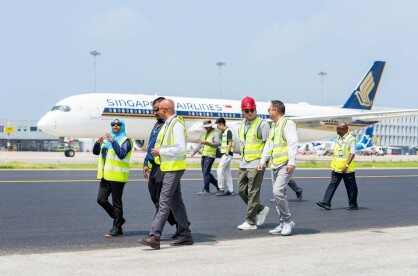When the Maldives is
mentioned, travellers often envision luxurious resorts and enchanting overwater
villas, painting an idyllic picture of this tropical paradise. While this
imagery perfectly encapsulates the dreamy experience for many visitors, the reality
for the country's residents is far from an idyllic heaven. Among the foremost
concerns for those living in the Maldives is the stark absence of affordable
housing, a pressing issue that dominates their perception of life in their own
nation.
The challenge of securing
housing in the Maldives mainly revolves around the capital city and the Greater
Male’ Area, as people from all corners of the Maldives are forced to move to
the city in hopes of better lives and a brighter future. However, with this
migration, over the years finding housing in the capital city has become harder
than ever. Individuals frequently find themselves compelled to share
accommodations with multiple others, forming makeshift households to manage
soaring living costs.
The dream of a comfortable, standalone home becomes a
distant reality, as the housing options available to the average person in the
country often fall short of ideal living conditions. This compromise not only
impacts the quality of life but also perpetuates the cycle of housing
unaffordability for those aspiring to establish a stable and fulfilling life
within their own country.
Despite the housing
challenges faced by residents in the Maldives, the government has been actively
introducing various housing schemes, such as the Hiya flat scheme, particularly
aimed at assisting those who cannot afford high rent in the Greater Male' Area.
These initiatives reflect a commendable effort to address the pressing issue of
affordable housing.
However, despite these endeavours, the housing problem
persists, leaving many to question the efficacy of the implemented measures.
The continual introduction of housing schemes, while a positive step, has not
translated into a lasting solution. Instead, it seems to create a cyclical
pattern, with new schemes emerging without a discernible impact on the
overarching problem.
This recurrence raises concerns about the root causes of
the housing issue and prompts a critical examination of the effectiveness and
sustainability of the existing strategies in truly resolving the persistent
challenges faced by the residents of the Maldives.
In practice, the persistent
emergence of these housing issues unveils a disconcerting reality, shedding
light on the escalating housing prices in the country. The government's
reduction of prices, particularly in places like Hiya flats designated as social
housing, should ideally mitigate the affordability crisis. However, a closer
examination reveals a concerning trend: even with the rent prices lowered by up
to 45 percent, the intended beneficiaries of the social housing initiative
have, in some instances, transformed into landlords.
Whether this is an
instance of the individuals who were meant to benefit from the housing scheme
to build a better livelihood turned into landlords, or whether corruption yet
again came into play and the housing was given away to those who do not fit the
criteria, there is always a losing party - those who actually deserved to get
flats from the scheme. With landlords constantly winning the battle, the power
dynamic within the housing scheme raises questions about the sustainability of
such initiatives and whether the current cycle of challenges will ever undergo
a meaningful transformation in the Maldives.
Repeatedly, we witness
instances of rent reductions, particularly within developments like the Hiyaa
flats. Despite these government-initiated reductions, the intended
beneficiaries, namely the tenants occupying these flats, often find themselves
excluded from the advantages of such measures. Landlords, wielding the
authority to set rental rates, consistently resist passing on these reductions
to their tenants. Consequently, the lofty goals of creating affordable housing
through these schemes are compromised, with many individuals forced to rent
government-subsidized housing at exorbitant prices.
This disconnect between the
government's intent and the actions of landlords not only perpetuates the
struggle for affordable housing but also underscores the need for more
comprehensive and effective measures to ensure that the benefits of rent
reductions genuinely reach those in need. The recurring pattern of unfulfilled
promises raises concerns about the sustainability of current housing
initiatives in the Maldives.
The ongoing challenges and
conflicts surrounding affordable housing in the Maldives have once again
surfaced, this time in the context of the government's commendable decision to
reduce the rent for Hiyaa flats to an affordable MVR 3,984.21. This amount aligns
notably well with the recently established minimum wage of MVR 8,000 in the
country.
On paper, this reduction appears promising for the residents of Hiyaa
flats, especially those seeking social housing. However, the reality paints a
different picture, as a significant portion of flat occupants turns out to be
landlords rather than genuine occupants in need of affordable housing.
Despite clear regulations
highlighting the illegality of leasing out entire Hiyaa flats for profit, a
pervasive trend persists. Many of these apartments are fully rented out to
families, with tenants paying amounts surpassing the actual rent of the entire
flat. This discrepancy underscores a critical issue: while the government's
initiative aims to provide economic relief to those struggling with housing
costs, the intended beneficiaries often remain locked in a cycle of financial
strain.
Consequently, individuals in dire need of affordable housing are still
compelled to work multiple jobs merely to secure social housing, revealing a
disconcerting gap between policy intentions and real-world outcomes in the
Maldives.
The influx of housing
schemes, while well-intentioned, has failed to yield the desired results,
leading to a cyclical pattern of unfulfilled promises and persisting
challenges. The disconnect between governmental initiatives and the actions of
landlords, who often exploit the system to their advantage, exacerbates the
struggle for affordable housing. The very individuals these schemes aim to
assist find themselves trapped in a paradox where reduced rent benefits are
seldom passed down to tenants, perpetuating a cycle of financial strain for
those genuinely in need.
The Hiyaa flat scheme,
designed to alleviate housing concerns, exemplifies the complexities embedded
in the quest for affordable living. Despite commendable efforts to reduce rent
prices, a concerning trend emerges with landlords profiting from the very housing
meant for those struggling financially.
This raises questions about the
transparency of the allocation process and whether corruption or loopholes in
the system contribute to the misallocation of social housing. In a scenario
where landlords consistently emerge victorious, the effectiveness and
sustainability of such initiatives are brought into question, leaving a
population deserving of support caught in the crossfire.
The housing challenges in
the Maldives highlight a stark contrast between the envisioned idyllic paradise
and the practical struggles faced by its residents. While the government's
commitment to housing schemes is evident, the persistent disconnect between
policy intentions and real-world outcomes demands a reassessment of strategies.
The cycle of unfulfilled promises, coupled with the exploitation of housing
initiatives, underscores the need for a holistic approach that not only
addresses rent reduction but also ensures that the benefits reach those truly
in need. Only through a comprehensive and transparent framework can the
Maldives hope to break free from the cycle of housing unaffordability and pave
the way for a more equitable and sustainable housing landscape for its
residents.






